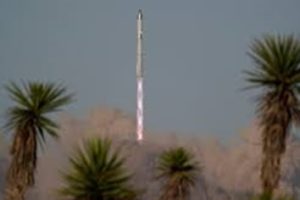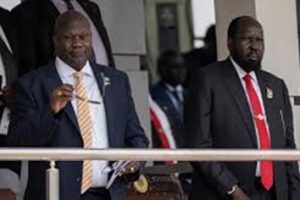Ukraine may have realised the first benefits of being allowed to strike Russian territory with Western weapons last week.
On May 26 and 27, France and Germany said they were allowing Ukraine to use their weapons against targets on Russian soil, following Russia’s new offensive against Kharkiv on May 10.

US sources told media on May 30 that the US was allowing Ukraine to use its weapons “for counter-fire purposes in Kharkiv”.
That suggested Ukraine was only allowed to fire back against a position from which incoming fire had originated, but not to use its intelligence to target weapons systems and troop concentrations pre-emptively.
“This US ambiguity misses an opportunity to deter Russian preparations for offensive operations elsewhere across the border into northern Ukraine,” said the Institute for the Study of War, a Washington-based think-tank.
Ukraine’s President Volodymyr Zelenskyy last week reported concentrations of troops north of the Ukrainian city of Sumy.
Ukraine’s first declared strike on Russian soil with Western weapons last Friday may have been based on a misunderstanding of these restrictions.
“The Defence Forces of Ukraine attacked the Kerch ferry crossing with ATACMS [US Army Tactical] missiles, which was actively used by the enemy to secure its grouping of troops in temporarily occupied Crimea,” announced Ukraine’s general staff.

The Kerch ferry crossing is on the Russian side of the Kerch Strait, which separates Crimea from the Russian region of Krasnodar Krai – nowhere near Kharkiv, which lies adjacent to the Russian region of Belgorod.
Ukraine claimed to have “significantly damaged two ferries carrying railway and car transports” and to have disrupted military logistics.
The US also said it was not allowing Ukraine to use its 300km-range (186-mile) ATACMS in Russia – only on occupied territories, essentially Crimea, which extends as much as 300km (186km) from Ukrainian front lines in places.
Ukraine’s next reported strike on Russian soil with a US weapon appears to have been in the designated area.
Over the weekend, Ukraine struck a Russian S-300 or S-400 air defence complex in Belgorod using high mobility army rocket systems (HIMARS). Geolocated footage showed two destroyed launchers and a damaged command post.
Germany’s ambassador to the UK expressed similar restrictions to those of the US, saying Ukraine could “defend itself” against attacks on the Kharkiv region from bordering Russian territory.
The UK and France, which were the first to lift restrictions on weapons use, have not publicly conveyed any such restrictions. Germany and the US have typically been more conservative, and Germany has made a point of never outpacing the US in military aid.
Once the theme of geographic restrictions was out of the bag, Ukraine’s allies began to make their stances clear on the use of F-16s, which they are due to start delivering this summer.

Denmark’s Foreign Minister Lars Lokke Rasmussen has said there would be no restrictions on using F-16 fighter jets it is giving Ukraine to strike targets inside Russia.
Netherlands Defence Minister Kajsa Ollongren sent a similar message on June 3.
“Once we hand it over to Ukraine, it’s theirs to use,” she told Politico.
The Netherlands has pledged 24 F-16s to Ukraine by the autumn. Denmark is to deliver its planes this summer.
Those positions stand in stark contrast to the position of Belgium, whose Prime Minister Alexander De Croo has said Ukraine may not use Belgian F-16s or other weapons to target Russia.
Belgium has been a cautious Ukraine ally, partly in order to protect its diamond trade, Jens Bastian, a fellow with the German Institute for International and Security Affairs, told Al Jazeera.
“We are finding more and more cases where this backsliding in maturity is resulting in open bitter conflict among EU states,” he said.
“Only in the 12th sanctions package [in December 2023] have we been able to address the major revenue issue of the diamond trade, which Belgium has been able to exclude from previous sanctions packages.”
Russia is the world’s biggest miner of diamonds, producing 42 million carats in 2022. Belgium hosts the world’s biggest diamond market.
Russian President Vladimir Putin responded to the lifting of geographical restrictions with renewed warnings that Moscow has not ruled out the use of nuclear force.
“We have a nuclear doctrine. Look what it says. If someone’s actions threaten our sovereignty and territorial integrity, we consider it possible for us to use all means at our disposal,” he told senior editors from Western news organisations on Wednesday.
US National Security spokesman John Kirby appeared to downplay the significance of the change, saying on Tuesday that Ukraine had always had the ability to shoot down Russian aircraft in Russian airspace, and had done so repeatedly.
Trouble on the ground
Ukraine’s commander-in-chief, Oleksandr Syrskii, said it was sending reinforcements to the Kharkiv front.
Khortytsia group spokesman Nazar Voloshyn estimated that 50 to 60 Russian soldiers were being killed in Chasiv Yar a day, and twice that number were being wounded. He did not offer an estimate of Ukrainian casualties, and Al Jazeera cannot verify figures given by either side.
Nonetheless, said Syrskyii, “these forces are not enough now to provide a full-scale assault and breakthrough in our defence”.
On Monday, Ukraine’s Military Media Centre said an estimated 8,790 Russian troops had been killed or wounded in the previous week, equivalent to 18 battalions. The army also estimated 103 tanks, 177 armoured combat vehicles and 280 artillery systems had been destroyed.
Ukraine has long said that Russia enjoys a wide artillery advantage as high as 10:1 in places.
A Russian military reporter said on Tuesday that Ukraine enjoyed an advantage of 3-4:1 in first person view (FPV) drones, which are short-range drones used to identify enemy positions. He said Ukraine’s drones “have become the leading factor in a fairly effective deterrence of our offensive actions for many months now.”
At the beginning of this year, Ukraine said it would build a million FPV drones on its soil. In the past few weeks, it has reported downing Russian FPV drones at a rate of more than 3,000 to 5,000 a week.

That dexterity seemed this week to extend to direct drone-to-drone combat.
Ukrainian army spokesman Dmytro Pletenchuk said a Ukrainian drone had shot down two Russian drones, a Lancet loitering munition and an Orlan-10 reconnaissance UAV, for the first time during this war.
“This is a new page in the history of small air combat in this war,” he said.
Ukraine also continued to target Russian assets with its domestically-built long-range drones, which carry no restrictions on use.
A week ago, Ukraine’s Security Service (SBU) said it had destroyed a Nebo long-range radar system near Armyansk in Crimea, which reportedly swept a 380km (236-mile) section of the southern front line. On the same day, its general staff said drones had succeeded in striking an oil depot in Krasnodar Krai.
Russia, too, targeted Ukrainian power infrastructure in a massive strike on Saturday comprising 47 drones and 53 missiles. Ukraine’s air force said it shot down almost all the drones and 35 of the missiles, but energy operators said two hydroelectric plants and two thermal power stations had been seriously damaged.
Source: ALJAZEERA




















Add Comment